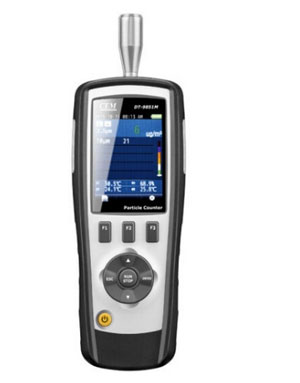A particle counter is an instrument that uses the principle of light scattering to count dust particles. Light scattering is related to factors such as particle size, light wavelength, particle refractive index, and particle absorption characteristics of light. However, in terms of the intensity of the scattered light and the size of the particles, there is a basic rule that as the surface area of the particle increases, the intensity of the scattered light of the particle increases. A certain flow of dusty gas passes through a beam of strong light, causing the particles to emit scattered light, which is projected onto the photomultiplier tube through the condenser, and the light pulse is converted into an electrical pulse, and the number of particles is obtained from the number of pulses. The particle size is obtained as a function of the intensity of light scattered by the particle and the particle size. As long as the intensity of scattered light is measured, the particle size can be deduced, which is the basic principle of the light scattering particle counter.

How to use a particle counter?
Different types of particle counters have some differences in function and operation interface, but the basic operation steps are similar. The specific operation steps are as follows:
- Turn on the power to preheat.
- Set the working parameters. If you don’t need to change it as last time, you can skip it. For specific button operations, refer to the product introduction of each instrument. Note that in the sampling state, the setting is invalid.
- After the setting is completed, the sampling measurement can be started and the data can be read.
- Connect to a printer to print, or export and print the data. Some products with built-in printers can print directly.
How to maintain the particle counter?
- After using the particle counter for a period of time, its optical system and detection system will change, such as the aging of the light source, luminous efficiency decreases or misfocusing, the lens is contaminated, thus the conversion sensitivity of the whole machine changes. Therefore, it is necessary to calibrate the particle counter regularly every year and adjust all aspects of the particle counter to obtain the best working condition.
- The working position of the instrument and the air inlet of the sampling tube should be at the same air pressure and the same temperature to avoid affecting the work of the air circuit system and generating condensation two damage the optical system. If you have to work again under differential pressure, the maximum differential pressure does not exceed 200 Pa in the conditions of differential pressure and temperature, will increase the measurement error, and even damage the instrument.
- When handling the instrument, it should be moved gently, less vibration, preferably in a special case.
Precautions for using particle counter
- It is forbidden to extract gases containing oily dirt and corrosive substances, and do not measure mixed gases that may react (such as hydrogen and oxygen). These gases may also create an explosion inside the counter.
- Do not start the particle counter when the inlet tube is capped or blocked.
- Do not sample compressed air without a high-pressure decompression device (such as a high-pressure diffuser). All particle counters are designed to operate at one atmospheric pressure. The working position of the particle counter and the sampling port should be in the same air pressure and temperature and humidity environment to ensure the normal operation of the instrument.
- The particle counter should be used in a clean environment to prevent damage to the laser sensor.
Timely monitoring of air is indispensable to reduce production losses caused by airborne particle pollution in clean rooms. sisco particle counters can simultaneously count 0.3, 0.5, 1.0, 3.0, 5.0, 10μm six particle sizes, direct observation of the instrument test, for your effective management of indoor air quality.

